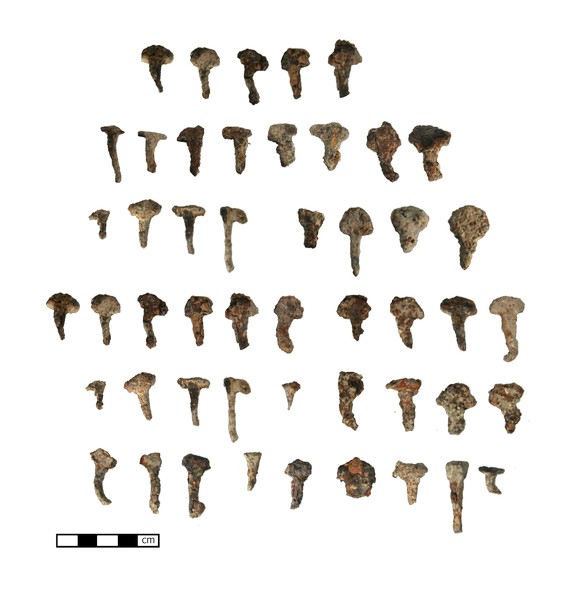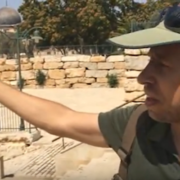Solomon’s Stables: History and Destruction
[youtube https://www.youtube.com/watch?v=bWMe3O-pGNc&w=560&h=315]
Learn More about Solomon’s Stables!
Hello everyone! We are starting a new video series on YouTube taking you on a tour of the Temple Mount! Check out the first video and see Solomon’s Stables! This structure has a rich history and is now the Al-Marwani Mosque. This is also the area of the Temple Mount from where most of our material originated.
Here are some of the highlights from the video and some more interesting facts about the site!
Fun Facts about Solomon’s Stables on the Temple Mount

Crusader Horseshoe Nails
The structure housed the horses of the Knights Templar during the Crusades. We have found many horseshoe nails, arrowheads, coins, and bits of armor from the Crusader period.
On the stones in the piers that hold up the vaulted ceiling of the structure, you can see the draft margin from the Herodian period. The other sides imitate this poorly, so we know these stones are in secondary use, originating from the Southern Wall of the Temple Mount platform. The structure was constructed in the Early Islamic Period.
As reconstruction, earthquakes, or other building happened on the Temple Mount over the last millennium, the debris would be removed to the Eastern side of the Temple Mount. Therefore, the material we are sifting is not necessarily specific to this corner of the Mount. Rather it is a sample of many different sites across the Temple Mount and shows us bits and pieces of the whole history of the Temple Mount.
There is possibly another structure beneath Solomon’s Stables because the walls of the Temple Mount platform could not hold so much soil without further support and the bedrock is very low.
The Destruction:
- In 1996, renovation began in Solomon’s Stables in order to convert it into a usable mosque (Al-Marwani Mosque). The wall between the Triple Gate and Solomon’s Stables was breached to create an entrance to the new mosque. Dirt heaps were removed from within the structure.
-

Digging in front of Solomon’s Stables (nov. 1999)
In 1999, a new monumental (huge) entrance way was opened. This was done by bulldozer and without archaeological supervision. This was initiated by the Northern Flank of the Islamic Movement in Israel in coordination with the Waqf. Prime Minister Barak gave oral permission for this new entrance as well on a smaller scale. Legally in Israel, any construction must first complete a salvage excavation to record any archaeology in the proposed construction zone. Especially in a place as sensitive and historic as the Temple Mount, this excavation is not only necessary legally but also ethically. No such excavation took place.
- You can still see evidence of different structures from different periods in the last millennium, but these structures were partially removed in the bulldozing without being recorded.
- The soil from the initial 1996 cleaning and the subsequent 1999 bulldozing was first dumped along the Eastern wall within the Temple Mount complex.
- From these heaps along the Eastern wall, 60 truckloads of soil was then moved to a municipal garbage dump where it got mixed with garbage and we could not sift it.
- After protest, the remaining 300 truckloads of earth were dumped in the Kidron Valley. This is area K.
- The paved plaza was also lowered and the 34 truckloads of earth was also dumped along the eastern side or in a compound in town. We call this area T.
- Some material remains on the Eastern side of the Temple Mount and will not be removed any time in the near future because of politics.
- We have completed about 70% of the sifting and hope to finish the remaining 30% when we have the budget to resume the sifting.
Reminder
If you would like to support our research, right now is a GREAT time to do that! Every donation made at www.half-shekel.org will be MATCHED and DOUBLED by a very generous supporter of our project.
Discover more from The Temple Mount Sifting Project
Subscribe to get the latest posts sent to your email.













Reblogged this on Kattukse Vrienden voor Israël.
I’m curious about the closed up gate on the east side of Southern corner. Is there access to the inside of that closed up gate? And the bend in the wall next to it. And does the long corridor in the stables go to that gate or opening that’s closed up. And has anybody excavated below the stables? Thank you for the information if you have it.